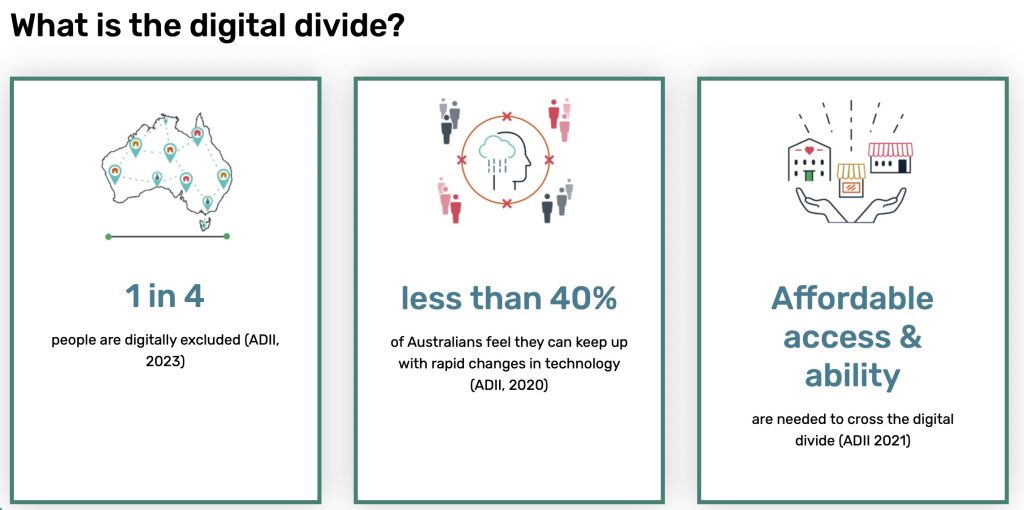Liyue Zhang 520028520
The rapid development and popularization of information technology have changed people’s lifestyles, and people are enjoying the convenience of the Internet and the development of the platform economy and are committed to studying more advanced technology. At the same time, however, it has been overlooked that there are still some people who do not enjoy the same level of access to information technology. According to the Australian Digital Inclusion Index (ADII), while digital inclusion in Australia is improving, one in four people is still not exposed to modern information technology. This phenomenon has been called the digital divide since the beginning of the 20th century, especially during the outbreak of the New Crown Virus in recent years, and Lisa (2002) found that the use of information technology is dependent on the economic and educational level of the population, and therefore the information divide and social inequality are mutually reinforcing. Such a problem of inequality in socio-technical resources not only exacerbates class disparities but also has an impact on national development on a global scale. Understanding the complexity of the social information divide and realizing its impact is the only way to address it more effectively.

The information divide is a manifestation of social inequality in the context of the Internet age. Educational opportunities, employment opportunities, the economy, and healthcare have been the main conflicts that have created the class gap. People with higher education have easier access to information and resources than those with higher education, leading to a vicious circle. In the age of the Internet, information has become more accessible but the marginalized are missing out on more opportunities due to lack of financial support and education and are unable to adapt to the computerization of social services. The Digital Divide is divided into three main levels, Access Divide, Usage Divide, and Skills Divide. From the point of view of the skills and usage divide, the elderly are the main affected group because of the lack of access to the Internet due to the lack of education on digital technology and low income, among other reasons. Even in our lives, we can see everywhere that the elderly cannot use high-tech products and will not take transportation, cannot use cell phone payment, and cannot get in touch. From an access perspective, the lack of economic and digital talent in some developing countries has led to a lack of physical infrastructure such as broadband connectivity, mobile devices, network signals, and so on. Thus, the development gap between countries is also reflected in the development of the Internet. Martin in 2016 stated that there has been a large gap in the broadband gap between high-income countries and low-income countries, especially during the period 2012-2014 (Martin, 2016). The information divide is not only a matter of access to digital technology, but fundamentally an unequal development of societies and countries.
The Information Divide is not only a magnifying glass, it exacerbates the class gap and inequality in social development, especially in areas that are highly dependent on digital technology such as education and healthcare. It played a huge role during the pandemic when online education grew rapidly due to the control and management of people’s inability to leave their homes. Remote areas were unable to support online learning due to a lack of infrastructure and resources, leading to a decline in student performance. The social impacts of this phenomenon include mortality rates, unemployment, and student mental health issues. In addition, the health care and medical services industry is also very dependent on digital technology, with developed countries having more sophisticated medical equipment and medical information and therefore better social health insurance systems. The technology gap in healthcare information and services has exacerbated health inequalities. This issue was also highlighted during the pandemic and attracted global attention, as the countries that had the technology to develop the medical technology were the ones that had the vaccines to fight the virus. The information gap thus highlights the differences in resources between social classes and exacerbates inequalities in social development.

However, the spread of information technology still faces controversy and concern. Some people believe that the spread of technology does not require much intervention and will be resolved over time, just like inventions and changes in history. However, the marginalization of poorer areas and marginalized groups requires that society take appropriate measures to avoid exacerbating social problems.
In addition, information overload and privacy and security issues resulting from the spread of digital technology are also causes of concern and rejection of the spread of information technology. Such concerns are legitimate and need to be avoided through effective measures in the process of information popularization. For example, digital literacy training can help people to effectively recognize real information from false information and learn to filter and evaluate to avoid information overload. Governments need to strengthen privacy laws to ensure that users’ information is secure, and digital platforms need to take steps to protect users’ data and comply with privacy policies. Measures to alleviate people’s concerns are necessary for the safe and sustainable development of digital technologies.
Technology companies and sharing economy platforms play a key role in facing the digital divide. Data show that more than half of the companies that currently own more than 25% of the profits in the US market are tech companies. The sharing economy brought about by the internet has not been an equal opportunity for all and tech companies have been the biggest beneficiaries. Therefore the influence and resources of tech companies make them the leading players in addressing the digital and economic divide, and fortunately, there are many tech companies that are already taking action. For example, Lenovo and Microsoft have partnered to implement the EdVision program, which aims to help schools in Southeast Asia provide students and teachers with online platforms and teacher volunteers to foster digital literacy education.
In addition, governments globally also have a key role to play in addressing the digital divide, and need to take into account the participation of marginalized groups of society as traditional public services are transformed into digital public services. Jyouti (2013) conducted a study around the measures taken by the UK government to drive the participation of socially marginalized people in the internet, where the UK government ensured the participation of the elderly and the disabled mainly through legislation, and each of the social e-services was evaluated for its efficiency and effectiveness for senior citizens. For developing countries, which are technologically and economically backward, Xavier’s 2022 proposal suggests that developing countries can enhance their entrepreneurial capabilities and upgrading through international trade (Xavier, 2022). International exchanges can not only increase economic development, which can be used to increase investment in science and technology innovation and development, but also learn from the technology of developed countries. It is the collaboration between the government and technology companies that will quickly lead to the popularization of information technology and solve the problem of the information divide.
Recognize the social impact of the information divide and understand the fundamental contradictions of the problem. Effective and relevant organizations address this social problem as an inclusive process, addressing inequality through education, law, science and technology, and management, providing equal access to information, and strengthening digital skills training to ensure that people in poor areas and marginalized populations fully participate in the digital society, thereby achieving sustainable development of digital technology.
Reference list
Choudrie, J., Ghinea, G., & Songonuga, V. N. (2013). Silver Surfers, E-government and the Digital Divide: An Exploratory Study of UK Local Authority Websites and Older Citizens. Interacting with Computers, 25(6), 417–442. https://doi.org/10.1093/iwc/iws020
Cirera, X., Comin, D., & Cruz, M. (2022). Bridging the technological divide : technology adoption by firms in developing countries. World Bank Group. https://doi.org/10.1596/978-1-4648-1826-4
Good Things Foundation Australia. (2022). The digital divide. 1 in 4 people in Australia are digitally excluded, putting them at risk of being left behind in our digital world. :https://www.goodthingsfoundation.org.au/the-digital-divide/
Hilbert, M. (2016). The bad news is that the digital access divide is here to stay: Domestically installed bandwidths among 172 countries for 1986–2014. Telecommunications Policy, 40(6), 567–581. https://doi.org/10.1016/j.telpol.2016.01.006
JunKi, L. (2022). The social problem that the information gap will create. https://onstarplus.com/archives/3371
Katherine, R.L. (2023). What the Covid-19 Pandemic Revealed About Remote School: The unplanned experiment provided clear lessons on the value—and limitations—of online learning. Are educators listening? Undark magazine https://www.smithsonianmag.com/innovation/what-the-covid-19-pandemic-revealed-about-remote-school-180982530/
Lenovo Asia-Pacific: Commercial. (2022). Lenovo EdVision: Smarter connections beyond the classroom. https://www.youtube.com/watch?v=O0BRgnwu-pw
Scoop. (2018). Older People Who Failed So Bad At Technology. https://www.youtube.com/watch?v=XEDIYo-8jCE
Servon, L. J. (2002). Bridging the digital divide : technology, community, and public policy. Blackwell Pub.
We-worldwide.com. (2021). Power Of Example: Tech’s Role in Closing the Digital Divide. https://www.we-worldwide.com/blog/posts/power-of-example-tech-s-role-in-closing-the-digital-divide